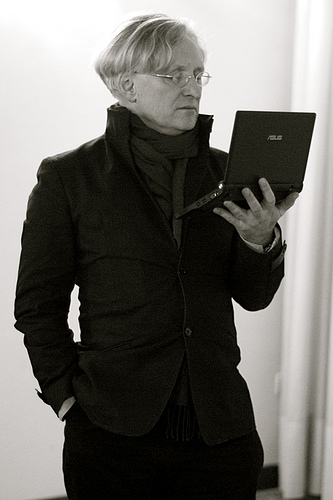
I will shortly be using the phrase "4½ Centuries earlier", so I just want you to imagine Amsterdam 4½ Centuries ago.
1667: The Eighty years war was over, but NL was at war with England. France attacks. Rembrandt was in his last years.

Now: the first town north of London that is no longer London.
Nice countryside, beautiful old market town.
Once important: Second city under the Romans, Important Monastery, Magna Carta, Shakespeare, War of the Roses.
Walking/Coaching distance from London, which led to the most pubs per square mile
Now a dormitory town, which has led to the most expensive houses in UK
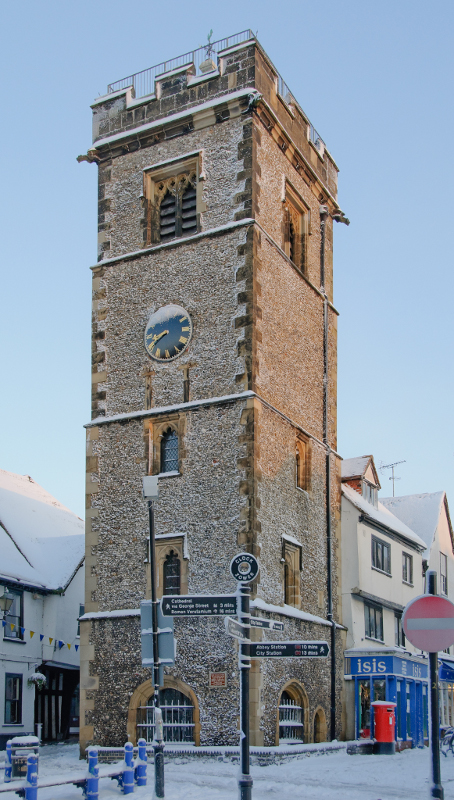 This is the only remaining mediaeval
clock tower in England.
This is the only remaining mediaeval
clock tower in England.
It contains a bell that was cast around 1350.
I used to walk past it every day on the way to school.
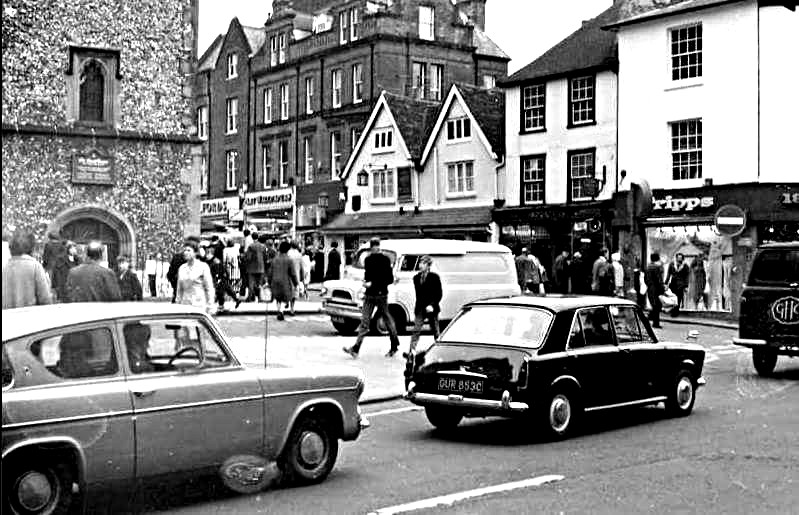 While searching the web for pictures
of the clock tower, I came upon this one. I had never seen this picture before,
I don't know who took it: but that is me with my best friend at the time,
walking in the direction of school.
While searching the web for pictures
of the clock tower, I came upon this one. I had never seen this picture before,
I don't know who took it: but that is me with my best friend at the time,
walking in the direction of school.
Shortly after the death of Chaucer
Still no printing presses
The time of re-emergence of English, after the Norman invasion:
That it was May thus dremed me
In time of love and jollite
That al thyng gynneth waxen gay
For there is neither busk nor hay
In May that it nyl shrouded ben,
And it with new leves wryen.
These greves eke recoveren grene,
That dry in wynter ben to sen,
And the erthe waxeth proude withal
For swete dewes that on it falle . . .
Interesting from a Dutch point of view: wax, it ben, eke (=ook).
School already existed 4½ centuries, when English looked like this.
Hwæt! Wé Gárdena in géardagum
þéodcyninga þrym gefrúnon·
hú ðá æþelingas ellen fremedon.
Oft Scyld Scéfing sceaþena þréatum
monegum maégþum meodosetla oftéah·
egsode Eorle syððan aérest wearð
féasceaft funden hé þæs frófre gebád·
wéox under wolcnum· weorðmyndum þáh
oð þæt him aéghwylc þára ymbsittendra
ofer hronráde hýran scolde,
gomban gyldan· þæt wæs gód cyning.
Barely recognisable as English. We, in, oft, he, wax (again), him, under. And from a Dutch point of view, the last sentence says: "dat was (een) goed koning".
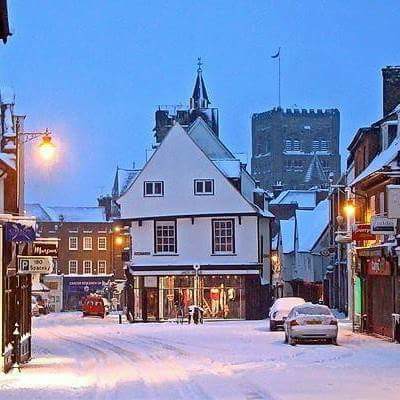 Here it is looking from the other direction. Why
build a clock tower in the shadow of a cathedral?
Here it is looking from the other direction. Why
build a clock tower in the shadow of a cathedral?
"kepe, make and rewle the clokke, beyng in seid tenement, and to smyte and kepe his resonable howres, and dayly and nyghtly to rynge or do rynge the bell of the same clok by the space of half amyle wey betwene the houres of viij and ix of the same clok at after noone, and immediatly as he can or may after the houre of iiij of the same clok before noone, at hys owne propre costes, expenses, and labour, or hys assignes duryng the seid terme. And shall make and kepe all reparacons necessarye to the seid tenement and clokke Excepte the reparacons of the bell and the claper perteynyng to the seid bell, and excepte also the stone werk and lede werk of the seid tenement, etc."
So one of the purposes of the Clock Tower was to sound the curfew (From French: Couvre Feu).
What this shows us is that in those days people slept from 8pm to 4 am: They still slept 8 hours, just from early evening to early morning.
Why?
In those days, light was mostly provided by candles.
Candles were very important products.
In fact there were two guilds for chandlers: one for those who made wax candles, and one for those who made tallow candles.
And candles were very expensive. It was not uncommon for people in some jobs to be partly paid in fire wood and candles.
So people went to bed at 8, and got up at 4 for economic reasons: if you slept in the hours of darkness, you would use the least number of candles.
Which meant that Midnight was the time of the night furthest from daylight, furthest from waking, the darkest part of the night, when no one would be about.
Nowadays, Midnight is not as special, in fact the time of night furthest from sleep is likely to be around 4 a.m., when the least people are on the street, and when traffic is at its quietest.
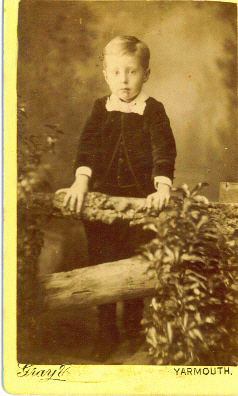
Born in 1880, a middle child in a family of 20(!) children.
1880: nearly no modern technologies.
In such a large household, as is to be expected, each child had a task, and it was my grandfather's to ensure that the oil lamps were filled.
It must have been indeed an exciting time, when light became something you could switch on and off.
This may well explain my grandfather's fascination with electricity, and why he set up a company to manufacture electrical switching machinery.
It is interesting to note that when Edison first introduced electrical lighting, he priced the electricity not based on the cost of manufacture, but so that the light would cost the same as equivalent light provided by candles. The advantage was the ease of use, and relative safety.
And indeed there are many reports of the deaths of well-to-do women because of candles.
I am going to be talking about the development of the cost of lighting over the years.
But first a reminder about graphs.
 When you turn a tap on,
you are adding a certain amount of water per minute to the
bath.
When you turn a tap on,
you are adding a certain amount of water per minute to the
bath.

So if we look at the graph of the bath filling, we get something like this:
We call this a linear function.
However, for instance, when a bank gives you interest on a bank account, it is not adding a fixed amount every year, but an amount based on how much you already have in the bank.
For instance, if they offer a 3% interest, then every year your money gets multiplied by 1.03.
If you have €1000 in your account, then at the end of the year you will have €1000 × 1.03, which is €1030. At the end of the second, you will have €1030 × 1.03, which is €1060.90.
This is called an exponential function.

Note the 'knee' around iteration 15. People often talk about an exponential function 'passing the knee'. This is a mistake.
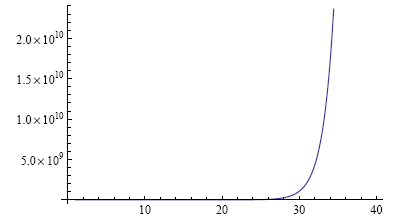
Note how there now seems to be nearly no action before iteration 26. The 'knee' is a fiction, a visual effect of the scaling used.
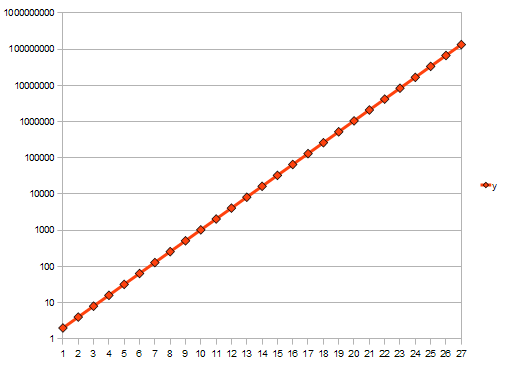 It is better to graph exponential functions in a different way.
It is better to graph exponential functions in a different way.
On the vertical axis, rather than going in steps of 1, 2, 3, ... we use steps of 1, 10, 100, 1000, ... Then the exponential graph looks like this:
(It actually doesn't matter what the step size is, as long as it is a multiplication: the graph still ends up looking the same).

Note the exponential decrease in costs.
It goes from candles, through oil lamps, to gas, and then electricity.
It has a halving time of about 13 years.
In 1800 you would have had to work between 6 and 12 hours to pay for the amount of light that an old-fashioned 100W bulb would supply in an hour.
Now you only have to work a bit under a half second to pay for that hour's worth of light.
And the price is dropping even faster now.
The study pre-dated LEDs
The cost of light produced by LEDs is decreasing exponentially. Haitz's 'law':
Every decade the price per lumen drops by a factor of ten.
This is a halving rate of about 3 years.
Moore's Law. Also network bandwidth: 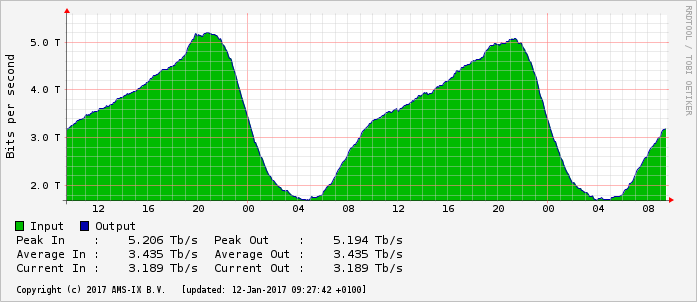
1988: 64Kbps
1989: 128Kbps
2017: 5Tbps (this represents a doubling period of just over a year).
And look! Lowest network use: 4am! The new midnight.
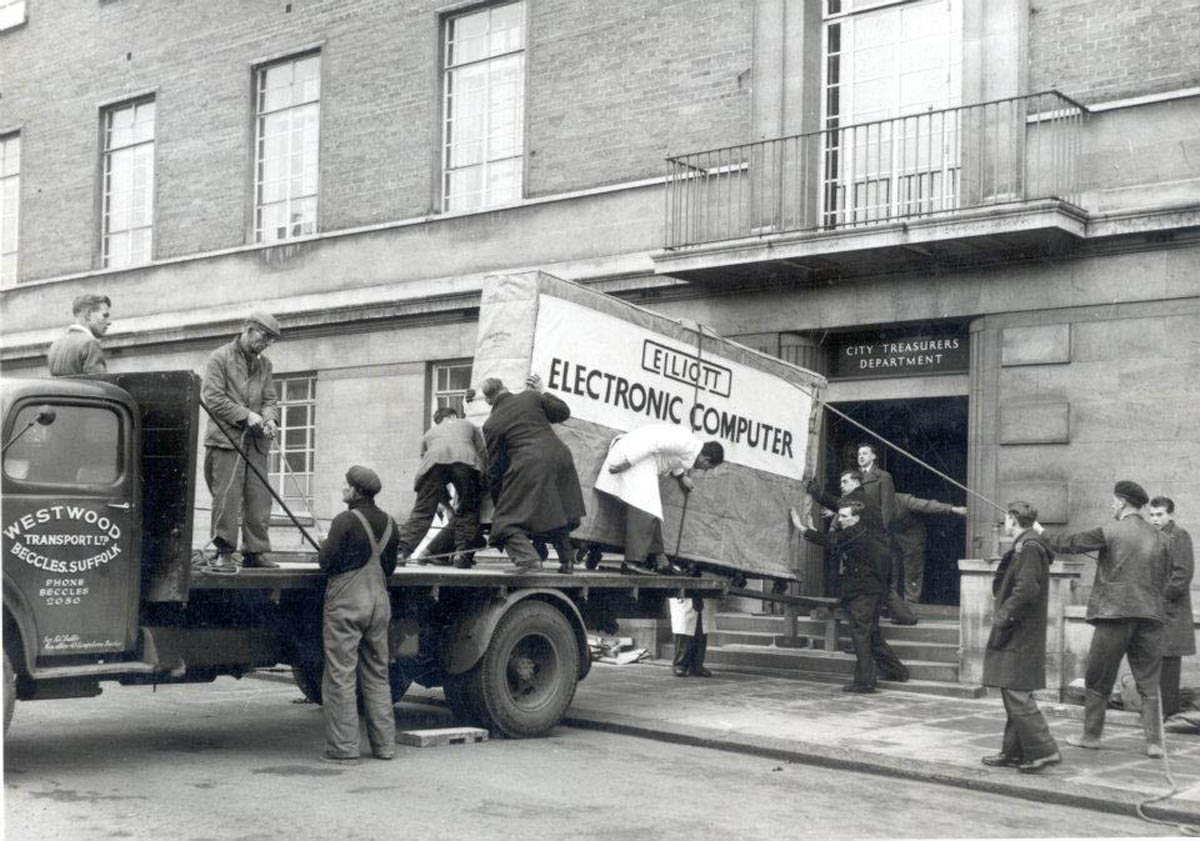
Just one of 21 cabinets making up the computer
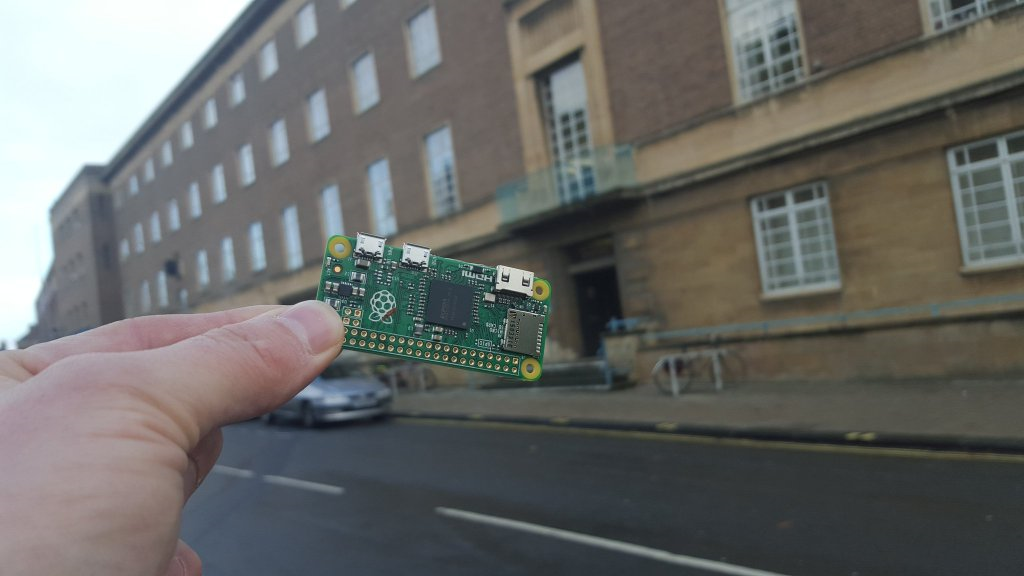
The first general-purpose computer that was so cheap it was given away free on the cover of a magazine.
Which do you think was faster: the Raspberry Pi or the Elliott?
The Raspberry Pi Zero is about one million times faster...
| Elliott 405 | Raspberry Pi Zero | Factor | |
|---|---|---|---|
| Year | 1957 | 2015 | 58 |
| Price | £85,000 (1957) (£2M-7M in 2015 money) | £4 (~ £0.15 in 1957 money) | ½M-2M |
| Instruction cycle time | 10.71-0.918 ms (93-1089 Hz) | 1 ns (1 GHz clock) | 1M |
| Main memory | 1280 bytes | 512 MB | ½M |
| Secondary memory | 16 kB drum store | 8 GB (typical micro SD flash card - not included) | ½M |
| Tertiary memory | 1.2MB (300 kword magnetic film) | 1TB (Typical external disk - not included) | 1M |
| Output bandwidth | 25 cps | 373 MB/s (HDMI) 60MB/s (USB) | 2M-10M |
| Weight | 3-6 tons | 9 g | ½M |
| Size | 21 cabinets, each 2m x 77cm x 77cm | 65mm x 30mm x 5.4mm | 2.3M |
| Median UK wage | Around £250 (men), £125 (women) | Around £30000 (men), £25000 (women) | 120-200 |
(Updated version of this original)
So the Raspberry Pi is:
A factor of a million million (billioen in Dutch, trillion in English).
A terabyte is a million million bytes: nowadays we talk in terms of very large numbers.
Want to guess how long a million million seconds is?
Is 30,000 years...
In other words, a really big number...
Funnily enough, a million million is almost exactly what Moore's Law would have us expect for that length of time (even though 1957 is before Moore's Law was thought of, and predates integrated circuits).
As I have pointed out in an earlier talk in this series, each order of magnitude change in cost has meant we have used computers in a different way:
| 1,000,000 | Mainframe |
| 100,000 | Minicomputer |
| 10,000 | Workstation |
| 1,000 | Home computer/Laptop |
| 100 | Netbook/Tablet |
| 10 | Project |
| 1 | Embedded |
Similarly, the reduction in cost of lighting has meant that people have adapted their sleep behaviour (and by the way, that cyclists in Amsterdam actually use lights now).
We have seen some effects of network cost reduction:
In the early days of internet, with dial-up lines, people would log on, check their mail, and then log off again.
When bandwidth became cheap enough not to have to meter, people went online continuously, (and started watching less television).
But as uplink speeds start going above 1MBps, we have an opportunity to make another change.
What is Facebook?
It is a personalised website, with software that allows you to easily add items, photos, news items, links, and control who can see them.
Your friends are able to comment on your items.
It then merges your items and your friends items into a stream that you can read and comment on as well.
And Facebook owns this content, and it owns you.
How could we do better?
The amount of content you produce is fairly small.
In the ten years I have been on Facebook, I have produced about 100MB of data, most of which is pictures and videos. The text is about 3½MB.
It would be easy to produce the software that lets you create your items in the same way, and then serve them from your home (the server could be in your modem).
It would be fairly easy to restrict who could see what, using well known techniques.
Knowing who your friends are, it would also be easy to aggregate your friends items, and create a stream to comment on.
And you would own your data.
And no one could spy on you.
And no one would be trying to sell you stuff.
I pick on Facebook because of its size and presence, but the same techniques could apply for most other sites that exist thanks to its users providing its content.
In fact one of the big problems with such sites is that there are many of them, and you have to choose which to use, or duplicate your work. Examples are photo sharing sites, geneology sites, selling sites.
But in fact, if you kept your own data, and then allowed sharing sites to aggregate your data, you would only have to do the work once, and you could join and leave sites without any loss of data or work.
Orders of magnitude change can affect how we act.
It is time for us to take advantage of the order of magnitude change in the uplink, and start making the internet a true two-way, distributed channel.
Slides are online.